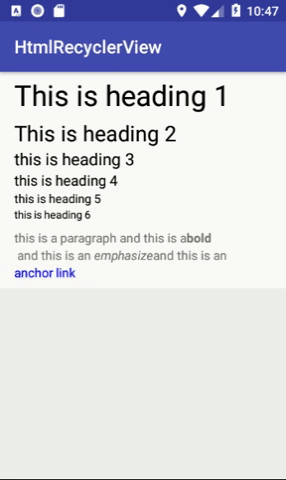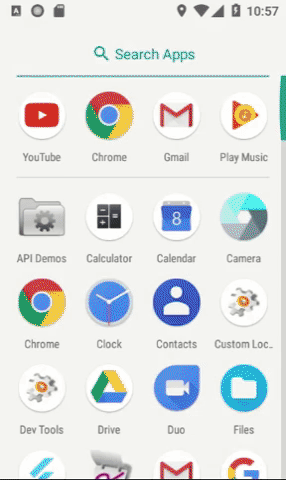This library has been under development for over 2 years, I don't think I will ever complete since the project we were working on got cancelled and I don't think I have enough time to finish it, PR are always welcome.
Converts a simple html page into A RecyclerView of native android widgets powered by Jsoup library and inspired by Medium Textview.
This library was design and developed by ME and we use this in our application which depends on a Content Management system and was never intended to replace browsers or act as one. this library simply gave us more control over html page than
WebView
dependencies {
implementation 'com.github.m7mdra:HtmlRecycler:0.1.11'
}This project is distributed using jitpack. Make sure you add it as a maven repository to your build.gradle
allprojects {
repositories {
maven {
url 'https://jitpack.io'
}
}
} |
 |
- APK
- Or simply
git clonethe repository and build theappmodule.
- Paragraph
- H1...H6
- Image
- Video
- Audio
- Ordered List
- Unordered List
- Description List
- Anchor Link
- IFrame
- Table
- DIV
val networkSource = NetworkSource("https://gist.githubusercontent.com/m7mdra/f22c62bc6941e08064b4fbceb4832a90/raw/ea8574d986635cf214541f1f5702ef37cc731aaf/article.html")
HtmlRecycler.Builder(this@MainActivity)
.setSource(networkSource)
.setAdapter(DefaultElementsAdapter(this@MainActivity) { element, i, view ->
}})
.setRecyclerView(recyclerView)
.setLoadingCallback(object : HtmlRecycler.LoadCallback {
override fun onLoadingStart() {
progressBar.visibility = View.VISIBLE
}
override fun onLoaded(document: Document?) {
progressBar.visibility = View.GONE
}
})
.build()The above code uses the existing implementation of DefaultElementsAdapter which extends ElementsAdapter class which inherently is a RecylcerView Adpater the DefaultElementsAdapter uses a layout resources files defined by me but they not styled probably and are very buggy (especially the video, audio and iframe ones).
Want to create your own adapter? just simply extend ElementsAdapter and override methods:
class BetterImplementationThanTheAuthorsAdapter : ElementsAdapter() {
override fun onCreateElement(parent: ViewGroup, elementType: ElementType): RecyclerView.ViewHolder {
when (elementType) {
ElementType.Paragraph -> {
return ParagraphViewHolder(LayoutInflater.from(parent.context).inflate(R.layout.row_paragarph, parent, false))
}
// Define other elements here
}
}
override fun onBindElement(holder: RecyclerView.ViewHolder, position: Int) {
val element = elements[position] //current element
if (holder is ParagraphViewHolder){
val paragraphElement = element as ParagraphElement
holder.paragraphText.text= paragraphElement.text
}
}
}
}Then replace the default adapter with your adapter:
HtmlRecycler.Builder(this)
.setSource(StringSource(Data.data))
.setAdapter(BetterImplementationThanTheAuthorsAdapter()) // this is a custom adapter
.setRecyclerView(recyclerView)
.build()Data can come from different sources, the library support the following:
- Assets
- File
- String
- Network (runs on
UI threadby default so you have to run it on different thread or write your own Source Implementation )
Simply implement the Source interface which will return a Document of the parsed Source:
class FileSource(val file: File) : Source {
override fun get(): Document {
return Jsoup.parse(file, "UTF-8")
}
}In DefaultElemetsAdapter class at line #27 l i defined a higher-order-function in the constructor method (which dose the same as defining an interface) and on line #75 we envoke the method passing our element and the position of the clicked view.
the library will mark any unimplemented element as UnknownElement and will delegate it to the android.text.Html#fromHtml class to convert it Spans and will be displayed on TextView
- Define a standard Layout styling.
- allow
NetworkSourceto run onUI threadwithout crashing. - Support the following elements:
-
Table -
Div -
Section -
SuperscriptandSubscrpit
-
- Test Element Extractors for different data sets.
-
add more control over paragraph element.paragraph element will be rendered using theandroid.text.Htmlclass rather than handled by the library - other thing that i come up with...
PR are welcome just use crtl+alt+L or (command + alt+L for mac ... idk if right) after every time your finish write code to format it.
if you are using this library in your project let me by sending an email at [email protected] know and i will post it here.
- be the first on the list.